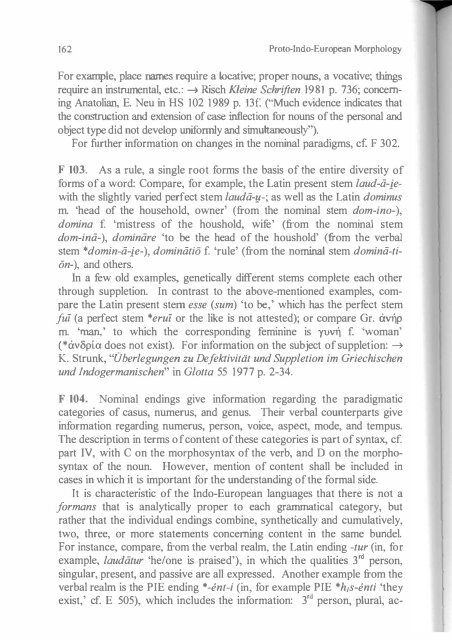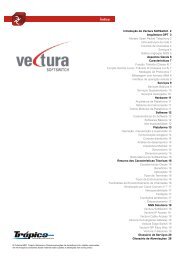You also want an ePaper? Increase the reach of your titles
YUMPU automatically turns print PDFs into web optimized ePapers that Google loves.
162 Proto-Indo-European MorphologyFor example, place names require a Iocative; proper noWlS, a vocative; thingsrequire an instnunental, etc.: --+ Risch Kleine Schriften 1981 p. 736; concerningAnatolian, E. Neu in HS 102 1989 p. 13f. ("Much evidence indicates thatthe construction and extension <strong>of</strong> case inflection for nouns <strong>of</strong> the personal andobject type did not develop Wlifonnly and simultaneously").For further information on changes in the nominal paradigms, cf. F 302.F 103. As a rule, a single root forms the basis <strong>of</strong> the entire diversity <strong>of</strong>forms <strong>of</strong> a word: Compare, for example, the Latin present stem laud-a-jewiththe slightly varied perfect stem lauda-!!-; as well as the Latin dominusm. 'head <strong>of</strong> the household, owner' (from the nominal stem dom-ino-),domina f. 'mistress <strong>of</strong> the houshold, wife' (from the nominal stemdom-ina-), dominare 'to be the head <strong>of</strong> the houshold' (from the verbalstem 'domin-a-je-), dominatio f. 'rule' (from the norninal stem domina-lion-),and others.In a few old examples, genetically different stems complete each otherthrough suppletion.In contrast to the above-mentioned examples, comparethe Latin present stem esse (sum) 'to be,' which has the perfect stemfUI (a perfect stem 'erul or the like is not attested); or compare Gr. aV1jpm. 'man,' to which the corresponding feminine is yuV1j f. 'woman'('avopia does not exist). For information on the subject <strong>of</strong> suppletion: --+K. Strunk, "Oberlegungen zu Defektivitiit und Suppletion im Griechischenund lndogermanischen" in Glolta 55 1977 p. 2-34.F 104.Nominal endings give information regarding the paradigmaticcategories <strong>of</strong> casus, numerus, and genus.Their verbal counterparts giveinformation regarding numerus, person, voice, aspect, mode, and tempus.The description in terms <strong>of</strong> content <strong>of</strong> these categories is part <strong>of</strong> syntax, cf.part IV, with C on the morphosyntax <strong>of</strong> the verb, and D on the morphosyntax<strong>of</strong> the noun.However, mention <strong>of</strong> content shall be included incases in which it is important for the understanding <strong>of</strong> the formal side.It is characteristic <strong>of</strong> the Indo-European languages that there is not aformans that is analytically proper to each grammatical category, butrather that the individual endings combine, synthetically and cumulatively,two, three, or more statements concerning content in the same bundel.For instance, compare, from the verbal realm, the Latin ending -tur (in, fo rexample, laudatur 'he/one is praised'), in which the qualities 3' " person,singular, present, and passive are all expressed. Another example from theverbal realm is the PIE ending '-ent-i (in, for example PIE 'hls-enti 'theyexist,' cf. E 505), which includes the information:3" person, plural, ac-General Information 163tive, and present.From the norninal realm, consider .th example <strong>of</strong> Lat.-us (in the example dominus) which expresses: nommalIve, smgular, andmasculine.An indication that the analytical process too was known in Pre-ProtoIndo-European is found in the accusative plural *-ns: Assuming .the comparison<strong>of</strong> the PIE acc. sg. *-m is not misleading, the accusalIve plural*-ns resulted from the combination <strong>of</strong>t-m (acc.) and -(e)s (pl.).B. VerbsI. General Info nnationF 200. The verb is the center <strong>of</strong> the verbal phrase. It <strong>of</strong>fers a muchgreater wealth <strong>of</strong>forms and contents than the substantive. For informationon syntax, cf. S 300ff.Occasionally the reproach is voiced that reconstruclIons <strong>of</strong> the PIE verbalsystem are disproportionately based upon knowledge <strong>of</strong> Greek andIndo-Iranian. Critics <strong>of</strong> the 'graeco-aryan' reconstruclIon model <strong>of</strong>tenpoint out the differentness <strong>of</strong> Anatolian, Tocharian, and Celtic. H ? wever,alternative models could not be <strong>of</strong>fered. In fact, where exact data IS available,it is again and again shown to be the case, that this differentness maybe seen as a secondary variation from the model as it is <strong>of</strong>fered in Greekand Indo-Iranian. Thus, the privileged place <strong>of</strong> Greek and Indo-Iranianseems not to be attributable to any bias in the research, but rather to thehistory <strong>of</strong> Greek and Indo-Iranian: --+ H. Rix "Das kellische Verbalsystemauf dem Hintergrund des indo-iranisch-griechischen Rekonstruktionsmodells"in Kolloquium Keltisch Bonn 1976 (1977) p. 132-158.F 201. Literature: - a) Concerning the verb in general: --+ BussmannLexikon d. Sprachw. 1990 p. 828f. s. v. 'Verb'; Metzler Lexikon Sprache1993 p. 675 s. v. 'Verb'; Lewandowski Linguist. Worterbuch 3 1994 p.1221f. s.v. 'Verb'; R. Stempel "Aspekt und Aktionsart, Tempus und Modus:Zur Strukturierung von Verbalsystemen" in IF 1 04 1999 p. 23ff. -b) Concerning the verb in Proto-Indo-European: --+ LIV 1998; BrugmannGrundrifJ 11-3 1916; Krahe ldg. Sprachw. II 1969 p. 50-89; Watkins Vrbaljlexion1969; Jasan<strong>of</strong>f Stative and Middle 1978; Szemen5nYI Em-.





